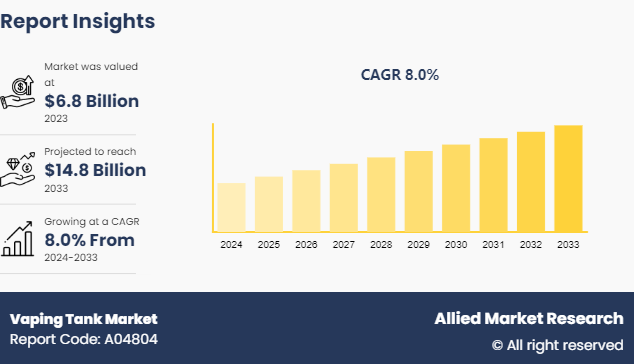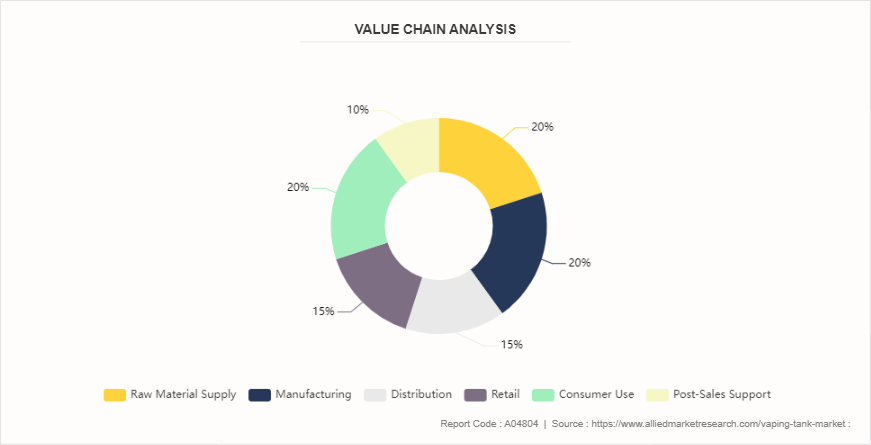Vaping Tank Market Research, 2033
Market Introduction and Definition
The global vaping tank market size was valued at $6.8 billion in 2023, and is projected to reach $14.8 billion by 2033, growing at a CAGR of 8% from 2024 to 2033. A vaping tank is an important component of vaping devices since it stores e-liquid and serves as a chamber for vaporization. It generally includes a liquid reservoir, an electrical coil or heating element, and a wick that absorbs and vaporizes the e-liquid. Vaping tanks are vital to a wide range of devices, from pod systems to sophisticated rebuildable tanks to sub-ohm tanks, with each offering unique characteristics geared to user preference for vapor output, flavor intensity, and simplicity of use.
The increasing acceptance of vaping as a smoking cessation method and alternative to regular cigarettes is driving up demand for vaping equipment. Tank design innovations, including enhanced wicking materials, customizable airflow, and greater e-liquid capacity, are improving the user experience and drawing more customers. Furthermore, the rising trend of customization and personalization in vaping, with customers looking for distinctive and high-performance tanks, is driving vaping tank market demands. The emergence of e-commerce and online retail platforms also increases access to a diverse selection of vaping tanks, which contributes to vaping tank market growth.

Key Takeaways
The vaping tank market study covers 20 countries. The research includes a segment analysis of each country in terms of value ($Billion) for the projected period 2024-2033.
More than 1, 500 product literatures, industry releases, annual reports, and other such documents of major vaping tank market overview participants along with authentic industry journals, trade associations' releases, and government websites have been reviewed for generating high-value industry insights.
The study integrated high-quality data, professional opinions and analysis, and critical independent perspectives. The research approach is intended to provide a balanced view of global markets and to assist stakeholders in making educated decisions in order to achieve their most ambitious growth objectives.
Key market dynamics
The increasing adoption of vaping as a smoking cessation tool is a significant driver of growth in the vaping tank market. As individuals seek alternatives to traditional cigarettes to reduce health risks, vaping has emerged as a popular choice due to its perceived lower harm. This shift is fueling demand for vaping tanks, which are essential components of vaping devices. With more smokers transitioning to vaping to quit or reduce smoking, the need for advanced and effective vaping tanks that enhance the vaping experience is rising, contributing to robust market expansion.
Regulatory challenges and restrictions are hindering the growth of the vaping tank market by imposing stringent rules on product design, marketing, and nicotine content. Varying regulations across different regions can create barriers to market entry and limit the availability of certain products. Additionally, compliance with complex legal requirements increases manufacturing costs and can slow down innovation. These regulatory hurdles may deter new entrants and restrict market expansion, affecting overall growth and development in the vaping tank market.
Product innovation and diversification present a significant vaping tank market opportunity for growth . As manufacturers develop new technologies and features, such as improved coil designs, adjustable airflow systems, and customizable tank options, they cater to a wide range of consumer preferences and enhance the overall vaping experience. By introducing advanced and unique products, companies can differentiate themselves from competitors and attract a broader audience, driving market expansion and meeting the evolving demands of vapers.
Value Chain Analysis of Global Vaping Tank Market
Raw Material Supply
The raw material supply step entails obtaining materials required for vaping tank production, including metals (such as stainless steel) , glass, plastic, and wicking materials. Suppliers offer these basic ingredients, which are essential for the longevity, safety, and performance of vaping tanks. The quality and cost of raw materials have a considerable influence on total product quality and price.
Manufacturing
In the manufacturing step, raw materials undergo processing and assembled into vaping tanks. This entails multiple procedures, including Moulding, machining, and assembling parts including the tank body, coils, and wicks. Advanced production techniques and quality control procedures are used to ensure that the tanks satisfy performance and regulatory requirements. Innovation in design and technology is critical at this level, impacting product distinctiveness and market competitiveness.
Distribution
In the distribution stage, finished vaping tanks are transported from manufacturers to wholesalers, distributors, and retailers. Efficient logistics and supply chain management are essential to ensure timely delivery and availability of products in various markets. Distribution channels include online retailers, vape shops, and specialty stores, which collectively help to reach end consumers and influence market reach and accessibility.
Retail
The retail stage involves selling vaping tanks to consumers through various outlets such as brick-and-mortar vape shops, online e-commerce platforms, and convenience stores. Retailers play a crucial role in product presentation, customer education, and driving sales. Effective marketing and customer service at this stage can enhance consumer experience and influence purchasing decisions.
Consumer Use
In the consumer use stage, end users purchase and utilize vaping tanks as part of their vaping devices. User feedback and preferences impact product development and innovation. The performance, reliability, and overall satisfaction with vaping tanks during this stage can drive brand loyalty and influence repeat purchases, contributing to long-term market success.
Post-Sales Support
Post-sales support involves providing customer service, handling returns and offering maintenance or repair services. This stage is crucial for addressing any issues that consumers may encounter with their vaping tanks and ensuring continued customer satisfaction. Effective post-sales support can enhance brand reputation, foster customer loyalty, and provide valuable insights for future product improvements.

Market Segmentation
The vaping tank market is segmented into product type, material, distribution channel, and region. On the basis of product type, the market is divided into sub-ohm tanks, clearomizers, rebuildable tanks (RTAs) , rebuildable dripping atomizers (RDAs) , and pod systems. As per material, the market is segregated into glass, polycarbonate, and stainless steel. Based on the distribution channel, the market is divided into on-specialty stores, online stores, and distributors & wholesalers. Region wise, the market is analyzed across North America, Europe, Asia-Pacific, and LAMEA.
Regional/Country Market Outlook
The vaping tank market is experiencing notable shifts across North America, Asia-Pacific, and Europe, driven by evolving consumer preferences and regulatory landscapes. The growing demand for customizable and high-capacity tanks, as well as increased interest in devices that offer enhanced flavor and vapor production, are the factors driving the market.
In North America, the market is bolstered by rising consumer awareness about alternatives to traditional smoking, coupled with a trend towards premium and technologically advanced vaping products. Regulatory scrutiny, however, poses challenges, potentially impacting vaping tank market size.
Asia-Pacific is witnessing rapid expansion due to a burgeoning middle class, increasing disposable incomes, and a significant rise in vaping adoption among younger demographics. Growth opportunities in this region are supported by the development of innovative vaping technologies and the rising popularity of nicotine salts.
Europe presents a dynamic market with varied regulations across countries, leading to both opportunities and obstacles. The European market is driven by stringent quality and safety standards, a growing emphasis on reduced-risk products, and an expanding consumer base seeking alternative smoking solutions. Overall, the market dynamics in these regions reflect a complex interplay of consumer demand for advanced features, regulatory influences, and technological advancements, all contributing to the evolving landscape of the vaping tank industry.
Industry Trends
There is an apparent movement from disposable vaping devices to refillable tanks, which is motivated by cost-effectiveness and environmental concerns. Customers are increasingly selecting refillable tanks because they provide a more customizable vaping experience.
Stricter laws in the European Union and the U.S. have resulted in improvements to vaping tank designs, notably in terms of tank capacity and nicotine delivery. Manufacturers are changing to meet rules that frequently limit tank capacities and impose safety requirements.
Sub-ohm vaping tanks, which enable lower resistance coils (less than 1 ohm) and generate greater clouds of vapor, are becoming increasingly popular among amateur vapers. These tanks are popular among cloud chasers because of their heightened flavor and vapor production.
Competitive Landscape
The major players operating in the market to increase vaping tank market share include SMOK Tech, Vaporesso, GeekVape, Voopoo, Uwell, Innokin, Aspire, Lost Vape, Wotofo, and Hellvape.
Other players in the vaping tank market include Freemax, HorizonTech, Sigelei, Vandy Vape, Oumier, iJoy, Rincoe, Dovpo, Augvape, and others.
Recent Key Strategies and Developments
In 2023, Altria Group, Inc. announced its acquisition of NJOY Holdings, Inc., a vaping startup. NJOY e-vapor products will be marketed by NJOY, LLC (NJOY) , a subsidiary of Altria. Additionally, NJOY's goods will be marketed by Altria Group Distribution Company.
In 2023, Imperial Brands plc announced the acquisition of nicotine pouches from TJP Labs, with the goal of entering the U.S. oral market. The purchase will allow ITG Brands, the company's U.S. division, to offer 14 distinct product kinds in a pouch that has proven successful in consumer testing. TJP Labs intends to use this purchase to further its commitment to producing solutions that support global harm reduction, consumer choice, and flexibility.
In January 2022, British American Tobacco invented an atomizer, a component that produces vapor. It generally consists of a tiny electric heater and an absorbent wick composed of glass fiber, cotton, or ceramic.
Key Benefits For Stakeholders
This report provides a quantitative analysis of the Vaping Tank Market segments, current trends, estimations, and dynamics of the Vaping Tank Market analysis from 2023 to 2033 to identify the prevailing Vaping Tank Market opportunities.
The market research is offered along with information related to key drivers, restraints, and opportunities.
Porter's five forces analysis highlights the potency of buyers and suppliers to enable stakeholders make profit-oriented business decisions and strengthen their supplier-buyer network.
In-depth analysis of the Vaping Tank Market segmentation assists to determine the prevailing market opportunities.
Major countries in each region are mapped according to their revenue contribution to the global Vaping Tank Market Statistics.
Market player positioning facilitates benchmarking and provides a clear understanding of the present position of the market players.
The report includes the analysis of the regional as well as global Vaping Tank Market trends, key players, market segments, application areas, and market growth strategies.
Vaping Tank Market Report Highlights
| Aspects | Details |
| Market Size By 2033 | USD 14.8 Billion |
| Growth Rate | CAGR of 8% |
| Forecast period | 2024 - 2033 |
| Report Pages | 235 |
| By Product Type |
|
| By Material |
|
| By Distribution Channel |
|
| By Region |
|
| Key Market Players | Uwell, Hellvape, Innokin, Vaporesso, SMOK Tech, Wotofo, GeekVape, Aspire, Lost Vape, Voopoo |
The global vaping tank market was valued at $6.8 billion in 2023, and is projected to reach $14.8 billion by 2033, growing at a CAGR of 8.0% from 2024 to 2033.
The vaping tank market registered a CAGR of 8.0% from 2024 to 2033.
The forecast period in the vaping tank market report is from 2024 to 2033.
The top companies that hold the market share in the vaping tank market include SMOK Tech, Vaporesso, GeekVape, Voopoo, Uwell,and others.
The vaping tank market report has 3 segments. The segments are product type, material, and distribution channel.
Loading Table Of Content...


